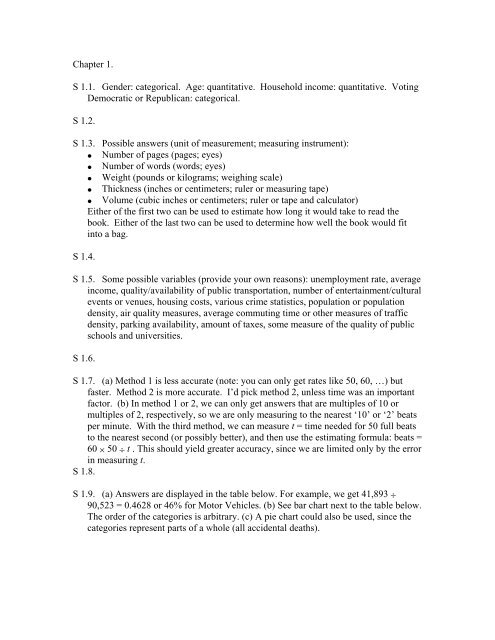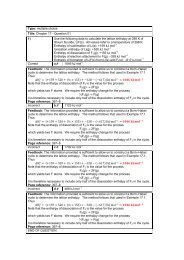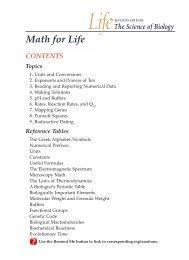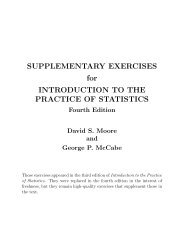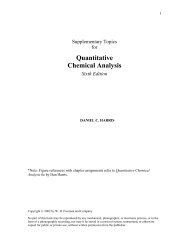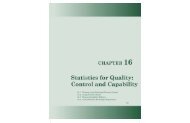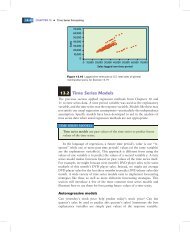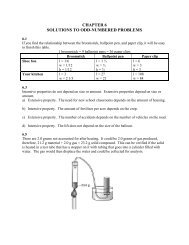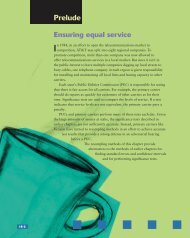Chapters 1 to 13 solutions - WH Freeman
Chapters 1 to 13 solutions - WH Freeman
Chapters 1 to 13 solutions - WH Freeman
You also want an ePaper? Increase the reach of your titles
YUMPU automatically turns print PDFs into web optimized ePapers that Google loves.
S 1.12.S 1.<strong>13</strong>. (a) Here is the time plot:(b) The plot shows a decreasing trend—fewer disturbances overall in the later years.There is also an apparent seasonal variation. Looking at the table, the spring and summermonths (April through Sept.) generally have the most disturbances—probably becausemore people are outside during these times.S 1.14.S 1.15. The plots for (a) and (b) are below:(a) Weights are generally lower for <strong>to</strong>ddlers with summer and early fall birthdays, andhighest for <strong>to</strong>ddlers born in winter. (b) Those born in spring and summer tend <strong>to</strong> be taller,while those born in November and December are shorter. (c) Both plots have extremesin the summer and winter, but they go in opposite directions—when one is high, the otheris low. Crudely put, the summer born two-year-olds are closer <strong>to</strong> the tall and thin mould,while winter born two-year-olds tend more <strong>to</strong>ward the short, heavy mould.S 1.16.S 1.17. $1,160,000 must be the mean, since the distribution will be highly skewed <strong>to</strong> theright. This will pull the mean out far beyond the median.
S 1.18.S 1.19. (a) Control: x = 366.3 grams, s = 50.8 grams. Experimental: x = 402.95 grams,s = 42.73 grams. (b) Both distributions appear <strong>to</strong> be roughly symmetric, with no clearoutliers (moderate departures from perfect symmetry are <strong>to</strong> be expected here,considering the very small sample sizes—hence, large influence of chance variation),so the mean and standard deviation should provide an appropriate description.S 1.20.S 1.21. The bigger value, $2.2 million, must be the mean, since the distribution will beskewed <strong>to</strong> the right. $800,000 is the median.S 1.22.S 1.23. (a) The stemplot (with split stems) shows a peak in the high 80’s, and a veryslight skew <strong>to</strong> the right. (b) x = 89.67, s 2 = 61.3089, s = 7.83. (c) M = 88.5, Q 1 =84.5, Q 3 = 93, IQR = 8.5 (note that your statssoftware may give different answers for thequartiles—Minitab gives 83.75 and 94.0).There are no outliers: that is, no scores liebelow Q 1 – 1.5 IQR = 71.75 or above Q 3 + 1.5IQR = 105.75. (d) In light of the small samplesize, the small degree of skewness present isn’tvery meaningful, so use of the standarddeviation can be justified. However, thequartiles would be a good alternative, if youthink the skewness might be for real (and golf scores might well be skewed).S 1.24.S 1.25. Use the information given <strong>to</strong> construct the four side-by-side boxplots shownbelow. Recentering pushedup verbal scoressubstantially. Beforerecentering, math scoreswere much higher thanverbal scores, butafterwards, the math andverbal scores were muchmore similar in distribution.
S 1.26.S 1.27.S 1.28.S 1.29. Using the 68-95-99.7 rule, we get 1.45 ± 2(0.40), or “0.65 grams <strong>to</strong> 2.25 grams”.You can also use 1.96 standard deviations instead of 2 standard deviations in thecalculation (from normal tables).S 1.30.700 − 544S 1.31. (a) X > 700 means Z > = 1. 51. From the table, the area under the curve103below 1.51 is 0.9345, so the desired area is 1 – .0655 = 0.0655. (b) X < 500 means Z500 − 544< = −0.43. From the table, the area under the curve below –0.43 is 0.3336.103500 − 544 800 − 544(c) 500 < X < 800 standardized becomes < Z < or –0.43 < Z < 2.49.103103The area between these values under the curve equals the difference of the two tableentries or 0.9936 – 0.3336 = 0.6600.S 1.32.1.7 − 3S 1.33. “Below 1.7” means “below = −1.63 ,” when standardized. The proportion0.8with standardized scores below –1.63 equals 0.0516 from the normal table.
2.1 standardized becomes –1.<strong>13</strong>, so the proportion of scores between 1.7 and 2.1equals the proportion between –1.63 and –1.<strong>13</strong>, standardized. From the normal tablewe get: 0.1292 – 0.0516 = 0.0776.S 1.34.S 1.35. Aside from a single outlier, the normal quantile plot below is quite straight. Ifwe ignore this one very low value, the distribution is quite close <strong>to</strong> normal.S 1.36.S 1.37. The normal quantile plot indicates that the data are approximately normallydistributed, hence the mean (35.09) and standard deviation (11.19) provide a gooddescription.Chapter 2.S 2.1. (a) Scatterplot is <strong>to</strong> theright. (b) There is a moderatepositive association betweenthe scores—no surprise, sincewe are observing the samegolfer on two rounds, andability should carry overfrom round <strong>to</strong> round. (c) Theoutlier is shown boxed in theplot. This player had a verypoor first round score, but
S 2.2.recovered <strong>to</strong> an average score on the second round. Perhaps this is an average golfer,who in round one had an off day. Then again, maybe this is a poor golfer who had anamazing first round. No way <strong>to</strong> tell what the s<strong>to</strong>ry is solely from examining the data.The point at (102,107) also stands far from the rest—but it does follow the samegeneral linear pattern as the other golfers.S 2.3. (a) Franklin is marked with a “+” in the lower left corner of the plot below.(b) There is a moderately strong positive linear association. One bank stands out a bit,with exceptionally high income relative <strong>to</strong> assets—bank # 9 (assets = <strong>13</strong>,150, income =144,177). The three rather big banks have high values for both variables, but do prettymuch follow the general pattern. Franklin does not stand out in the plot.S 2.4.S 2.5. (a) The means are 1520, 1707, 1540, 1816 grams, for pecking order 1, 2, 3, 4,respectively. They are indicated with the “x” marks, which are connected in thescatterplot below.
(b) Contrary <strong>to</strong> our expectation, the heaviest chickens tend <strong>to</strong> stand last in peckingorder, while those highest in the pecking order were actually the lightest, on average.S 2.6.S 2.7. (a) Scatterplot is <strong>to</strong> the right.(b) With the exception ofNorthern Ireland (upper leftcorner), there is a moderatepositive association. (c) r =0.224; without Northern Ireland,r = 0.784. Removing NorthernIreland—which lies far from thegeneral linear pattern—makesthe pattern much more tightlylinear.S 2.8.S 2.9. (a) Standard deviations here measure variability in returns from year <strong>to</strong> year, alsocalled volatility. The Income Fund is more consistent in annual returns (less variationabout its average), while the more volatile Tech fund will jump up and down, inreturn, much more dramatically from year <strong>to</strong> year (often inves<strong>to</strong>rs are willing <strong>to</strong>accept greater volatility in return for a greater average annual return). (b) TheMagellan Fund, with the higher correlation, tends <strong>to</strong> rise and fall, in near lockstep,with the S&P index. The Small Cap Fund also generally rises and falls with theindex, but the actual monthly return is not tied <strong>to</strong> the index nearly as closely.S 2.10.
S 2.11. (a) The scatterplot—on the left, below—shows a moderately strong positivelinear relationship. (b) r = 0.941. About 88.6% (r 2 = .886) of the variation inmanatee deaths is explained by powerboat registrations, so predictions are reasonablyaccurate. (c) yˆ = −41.4+ 0. 125x, from which we predict –41.4 + 0.125(716) = 48manatee deaths. (d) We predict –41.1 + 0.125(1000) = 208, but since this is quite anextreme extrapolation (in number of boats, as well as time), we have little faith in thereliability of such a prediction. (e) The new points have been added and labeled inthe scatterplot shown on the right, below. A couple of the new points follow theprevious pattern, while a couple lie below it—indicating fewer deaths than expected.There is, perhaps, a weak indication of some possible effect from the new measurestaken. (f) We predict –41.1 + 0.125(716) = 48.4 which noticeably exceeds theobserved mean of 42.0 for the three years. Perhaps the inaccuracy of this predictionreflects some effect from the new measures taken <strong>to</strong> lessen manatee deaths.S 2.12.S 2.<strong>13</strong>. For degree-days (x): x = 21.54 and s x = <strong>13</strong>.42. For gas consumption: y = 558.9and s y = 274.4. The correlation r = 0.989. If we are predicting gas use from degreedays,the slope of the regression line b = (0.989)(274.4)/(<strong>13</strong>.42) = 20.22 (cubic feetper degree-day) and the intercept a = 558.9 – (20.22)(21.54) = 123.4. So ourprediction equation is: Gas = 123.4 + 20.22 Degree-days (same as before but forsmall differences due <strong>to</strong> rounding).On the other hand, if we wish <strong>to</strong> predict degree-days from gas consumption, weget a slope = (0.989)(<strong>13</strong>.42)/(274.4) = 0.0484 (degree-days per cubic foot) andintercept = 21.54 – (0.0484)(558.9) = –5.51. So our prediction equation is: Degreedays= –5.51 + 0.0484 Gas.S 2.14.S 2.15. (a) The plot below suggests a weak positive association between price andconsumption—the opposite of what we expected. (b) The regression line is shown onthe plot and displayed at the <strong>to</strong>p ( ŷ = 44.87 + 9.50 x), as is the proportion of thevariation in beef consumption that can be explained by this regression on price (r 2 =35.8%).
(c) The residual plot vs. time, below, shows a pattern of rising and falling, rather thanpurely “random” fluctuations. There are clearly systematic effects of time not accountedfor in our regression.S 2.16.S 2.17. Both reading ability and shoe size tend <strong>to</strong> increase with the lurking variable—age. See below.ReadingAbilityShoeSize
S 2.27. (a) There is some upward curve <strong>to</strong> the scatterplot below, left, suggesting thepossibility of exponential growth. (b) See plot below, right. The fitted line is:Log(Spend) = – 98.75 + 0.0525 Year. Growth was faster from about 1965 <strong>to</strong> 1980(the points rise faster than the line), slower otherwise. (c) We predict –98.75 +0.0525(1992) = 5.83 for log of spending, or 10 5.83 = 676,083 millions of dollars—wayabove actual spending. [Note: answers are very sensitive <strong>to</strong> rounding here.]S 2.28.S 2.29. (a) See plots below.(b) Growth was more exponential than linear (since the log plot is fairly linear over thatrange). (c) If the points from 1980–1995 on the second graph are linear, it would suggestexponential growth at a slower rate. They look fairly linear, but the data for this period inthe first graph look possibly even more linear. To see the trends more clearly, delete theother years, and re-plot both graphs—it appears that growth is closer <strong>to</strong> linear than <strong>to</strong>exponential in this period. (d) Vehicle registrations dropped during World War II.S 2.30.S 2.31. Plots below. They suggest exponential growth at one rate up <strong>to</strong> 1965, and fromthen at a slightly lower rate. There is one index reading, for 1985, that stands out asan unusually high value.
S 3.10.S 3.11. (a) See below. The response variable is the company chosen.Random AssignmentGroup 1 Brochure B20 women with child careGroup 2 Brochure A20 women with no child careObserve companychosen(b) If we assign labels 01–40 (down the columns of names), and then read offconsecutive two digit selections beginning on line 121 in Table B (just ignore theselections 41–00, which correspond <strong>to</strong> no one), the corresponding subjects (in the orderselected) are listed in the table below—they will get the child-care brochure.29-Ng, 07-Cortez, 34-Sugivara, 22-Kaplan, 10-Durr, 25-Lippman, <strong>13</strong>-Garcia, 38-Ullman,15-Green, 05-Consico, 09-Danielson, 08-Curzakis, 27-McNeill, 23-Kim, 30-Quinones,28-Morse, 18-Howard, 03-Afifi, 01-Abrams, 36-TraversS 3.12.S 3.<strong>13</strong>. (a) An experiment is not possible, since the explana<strong>to</strong>ry variable (gender) cannotbe imposed on the subjects. (b) An experiment is possible, but there may be someethical difficulties in randomly assigning surgical treatments <strong>to</strong> cancer patients(especially if the attending physician recommends the other treatment for the patient).S 3.14.S 3.15. (a) The specific effects of the meditation technique cannot be distinguished fromthe effect of investing a month in any activity with the expectation that it will reduceanxiety. (b) The experimenter expects meditation <strong>to</strong> lower anxiety, and probablyhopes <strong>to</strong> show that it does. This may unconsciously influence the diagnosis. (c)Subjects must be randomly assigned <strong>to</strong> meditation or a control group. The controlgroup might receive no treatment other than the before and after interview (whichitself may affect anxiety) or might receive an alternative treatment such as physicalexercise. Ideally, the interviewer should not know the treatment received by anindividual, but this may be difficult in practice. An “objective” test of anxiety avoidsthis problem. If an interviewer is used, he or she should be an outside party with nostake in the experiment.
S 3.16.S 3.17. Use a randomized block design—step 1: randomly assign the men <strong>to</strong> the 6treatments; step 2: randomly assign the women <strong>to</strong> the 6 treatments.S 3.18.S 3.19. The fac<strong>to</strong>rs are whether or not the letter has a ZIP code (2 levels: yes or no) andthe time of day the letter was mailed—the number of levels here may vary. To dealwith lurking variables, all letters should be the same size, sent on the same day, <strong>to</strong> thesame city. Rather than settling on just one city, one letter size, one day of the week,etc., an alternative would be <strong>to</strong> decide <strong>to</strong> vary the day (or size, or city) in a systematicfashion—in which case we would make it in<strong>to</strong> an additional fac<strong>to</strong>r in the study.S 3.20.S 3.21. (a) Below. (b) The patients are numbered from 01 <strong>to</strong> 30. Using line 125, thosereceiving the beat blockers are those numbered: 21, 18, 23, 19, 10, 08, 03, 25, 06, 11,15, 27, <strong>13</strong>, 24, 28. The others get the placebo.Group 1 Treatment 115 patients Beta blockerRandom Assignment Observe pulse rateGroup 2 Treatment 215 patients PlaceboS 3.22.S 3.23. (a) There are two fac<strong>to</strong>rs: temperature and stirring rate, and six treatments,consisting of the various temperature–stirring rate combinations: 50 degrees and 60rpm, 50 degrees and 90 rpm, etc. Twelve batches are needed (in order <strong>to</strong> have at leasttwo replicates at each treatment). (b) Below. (c) From line 128, the first 10 numbers(between 01 and 12) are 06, 09, 03, 05, 04, 07, 02, 08, 10, 11. So the 6th and 9thbatches will receive treatment 1; batches 3 and 5 will be processed with treatment 2,etc. [Number the treatment combinations 1 <strong>to</strong> 6, in any order you prefer.]Group 1 Treatment 12 batches 50°C / 60 rpmGroup 2 Treatment 22 batches 50°C / 90 rpmGroup 3 Treatment 3Random 2 batches 50°C / 120 rpm ObserveAssignment yield
Group 4 Treatment 42 batches 60°C / 60 rpmGroup 5 Treatment 52 batches 60°C / 90 rpmGroup 6 Treatment 62 batches 60°C / 120 rpmS 3.24.S 3.25. Population: Employed adult women. Sample: The 48 club members who returnthe questionnaires. 52% did not respond.S 3.26.S 3.27. Beginning with Agarwal and going down the columns, label the people with thenumbers 01–28. From line <strong>13</strong>9, we select: 04-Bowman, 10-Frank, 17-Liang, 19-Naber, 12-Goel, <strong>13</strong>-Gupta.S 3.28.S 3.29. Voluntary response is the big reason. Opponents of gun control usually feel morestrongly than supporters, and so are more likely <strong>to</strong> call. The sampling method alsoreduces response from poorer people by requiring a phone and willingness <strong>to</strong> pay forthe call.S 3.30.S 3.31. (a) Label the students from 0001 <strong>to</strong> 3478. (b) Taking four digits at a time,beginning on line 105, gives 2940, 0769, 1481, 2975, <strong>13</strong>15.S 3.32.S 3.33. The 1128 letters are a voluntary response sample, which do not necessarily reflectthe opinions of her constituents, since persons with strong opinions on the subject aremore likely <strong>to</strong> take the time <strong>to</strong> write.S 3.34.S 3.35. Both 335grams and 289grams are statistics.S 3.36.
S 3.37. The “margin of error” or variability would be practically the same for a samplefrom either population. (This makes the assumption that the poll’s sample size wasless than 800,000—10% of the population of New Jersey. Going by the reportedmargin of error, this must be so.)S 3.38.S 3.39. p = 22/90 = 0.2842. (b) Assign labels 01 <strong>to</strong> 90 <strong>to</strong> the players, then take randomdigits two at a time. Answers will vary with the starting line chosen in Table B; if thesample contains, say, 3 offensive backs, then pˆ = 3/15 = 0.2. (c) The distribution thatyou get should look roughly bell-shaped, centered not <strong>to</strong>o far from p = .2842. (d) Themean of your 20 proportions should be somewhat close <strong>to</strong> .2842. Since thedistribution centers roughly at p (with more simulated samples, it would centerexactly at p), this suggests that pˆ may be an unbiased estima<strong>to</strong>r of p.Chapter 4.S 4.1. (a) We expect probability ½ (for the first flip and for any flip of the coin). Yourobserved proportion should be in the general vicinity of 25/50. (b) Let m = thenumber of times, in the 50 trials, that the first head occurs on an odd <strong>to</strong>ss. Take m/50as your estimate (the true probability is 2/3).S 4.2.S 4.3. (a) 0. (b) 1. (c) 0.01 (d) 0.6 (or 0.99 but “more often than not” is a rather weakdescription of an event with probability 0.99).S 4.4.S 4.5. (a) S = {all numbers between 0 and 24} in units of hours. (b) S = {0, 1, 2, … ,11000}. (c) S = {0, 1, 2, …, 12}. (d ) S = {0, 0.01, 0.02, 0.03, …} in units of dollars,or approximately S = {all numbers greater than or equal <strong>to</strong> 0} (e) S = {all positiveand negative numbers}. Note that the rats can lose weight.S 4.6.S 4.7. (a) 0.1, <strong>to</strong> make them all sum <strong>to</strong> 1.0 (b) 0.3, <strong>to</strong> make them all sum <strong>to</strong> 1.0 (c)P(plain M&M is red, yellow, or orange) = .2 + .2 + .1 = 0.5. P(peanut M&M is red,yellow, or orange) = .1 + .2 + .1 = 0.4.S 4.8.
S 4.23. µ = (0)(.1) + (1)(.15) + (2)(.3) + (3)(.3) + (4)(.15) = 2.25.S 4.24.S 4.25. No. Assuming all “at-bat’s” are independent of each other, the 35% figureapplies only <strong>to</strong> the long run of his career, not <strong>to</strong> “short runs”. The chances are still35% next time up.S 4.26.S 4.27. µx = (0)(.03) + (1)(.16) + (2)(.3) + (3)(.23) + (4)(.17) + (5)(.11) = 2.68. σx 2 = (0–2.68) 2 (.03) + (1 – 2.68) 2 (.16) + (2 – 2.68) 2 (.3) + (3 – 2.68) 2 (.23) + (4 – 2.68) 2 (.17) +(5 – 2.68) 2 (.11) = 1.716, which square-rooted gives σx = 1.3106.S 4.28.S 4.29. (a) The mean number of people saved by the first program is: µ = (600)(.5) +(0)(.5) = 300 people. (b) There is no difference (except in the phrasing): saving 400is the same as losing 200. (c) No. The choice seems <strong>to</strong> be based on how the optionssound (emphasizing how many will surely be saved vs. the bleak proposition of howmany will surely be lost).S 4.30.S 4.31. (a) Asian s<strong>to</strong>chastic beetle: µ = (0)(.2) + (1)(.3) + (2)(.5) = 1.3 females. Benignboiler beetle: µ = (0)(.4) + (1)(.4) + (2)(.2) = 0.8 females. (b) When a largepopulation of beetles is considered, each generation of Asian s<strong>to</strong>chastic beetles willcontain close <strong>to</strong> 1.3 times as many females as the preceding generations, so thepopulation will grow steadily. Each generation of benign boiler beetles, on the otherhand, contains only about 80% as many females as the preceding generation,resulting in smaller and smaller successive populations.S 4.32.S 4.33. (a) µZ = 0.5µX + 0.5µY = 0.065. σ 2 Z = 0.5 2 σ 2 X + 0.5 2 σ 2 Y = 0.020225, so σZ =0.1422. (b) You will want <strong>to</strong> weight the s<strong>to</strong>cks more heavily, with a choice of αbigger than 0.5. For any choice of α, you can do the calculations directly, similar <strong>to</strong>those above, and you can also check your answer by plugging your choice of α in<strong>to</strong>the following general result: µZ = αµX + (1–α)µY = 0.02 + 0.09α and σZ =S 4.34.222 2X + 1−α)σ Yα σ ( = 0.0025 − 0.005α+ 0.0809αS 4.35. P(A and B) = P(A) P(B|A) = 0.1472.2
S 4.36.S 4.37. P(A|B) =P(A and B)= 0.8045/0.9460 = 0.8504P(B)S 4.38.S 4.39. P(knows the answer | gives the correct response) =P(knows the answer and gives the correct response) 0.75= = 0.9375 (where we have used theP(gives the correct response)0.80result from S 4.38).S 4.40.S 4.41. (a) P(X ≥ 50) = 0.14 + 0.05 = 0.19. (b) P(X ≥ 100 | X ≥ 50) = 0.05/0.19 = 5/19 or0.263. In the numera<strong>to</strong>r, we need the probability that the income is bigger than 100and also bigger than 50, but this can only be the case if the income is bigger than 100.S 4.42.0.09 9S 4.43. (a) P(female | A) = = = 0.39<strong>13</strong>.0.14 + 0.09 230.01+0.04 5= = 0.1786.0.11+0.12 + 0.01+04 28(b) P(female | D or E) =S 4.44.Chapter 5.S 5.1. (a) There are 150 independent observations, each with probability of “success” (aresponse) equal <strong>to</strong> 0.5. (b) µ = np = (150)(0.5) = 75. (c) P(X ≤ 70) = 0.23<strong>13</strong> (exactresult using software), or 0.2327 (using normal approx. with continuity correction,and normal table in text: z = –0.73), or 0.2061 (using normal approx. withoutcontinuity correction, and normal table in text: z = –0.82). (d) Use n = 200, since(200)(0.5) = 100.S 5.2.S 5.3. P (.<strong>13</strong> ≤ pˆ ≤ .17) = P(–0.79 ≤ Z ≤ 0.79) = 0.5704. For more accuracy, usesoftware and apply the Binomial distribution <strong>to</strong> find: P(26 ≤ X ≤ 34) = 0.6274.Without software, you can improve on the normal approximation above by using acontinuity correction: P(25.5 ≤ X ≤ 34.5) = P(–0.89 ≤ Z ≤ 0.89) = 0.6266. (b) Theprobability increases <strong>to</strong> 0.8968, 0.9774, and 0.9986, for sample sizes of 800, 1600,and 3200 respectively (using the normal approx. with continuity correction, and your
S 5.4.normal tables; omit the continuity correction and you get: 0.8858, 0.9750, 0.9984).As the sample size increase, it becomes a near-certainty that the sample proportionwill be within 2% of the true value. [Accuracy of estimation increases with samplesize.]S 5.5. X, the number who have never married, has a Binomial (n = 10, p = 0.25)distribution. (a) P(X = 2) = 0.2816. (b) P(X ≤ 2) = 0.5256. (c) P(8 or 9 or 10 havemarried) = P(X = 2 or 1 or 0) = 0.5256.S 5.6.S 5.7. X, the number of free throws made, has a Binomial distribution with n = 6 and p =0.7. P(X ≤ 2) = 0.0705, calculated using either the Binomial formula three times, orthe Binomial tables in the text (switch <strong>to</strong> counting misses, rather than successful freethrows, so that you can use the B(6, 0.3) table <strong>to</strong> find P(#Misses ≥ 4)). This is fairlysmall, which gives perhaps some reason <strong>to</strong> doubt that it was just bad luck (such apoor performance should occur only 1 game in 14 by bad luck alone).S 5.8.S 5.9. The sample mean is normally distributed with a mean of 123mg, and standard124 −123deviation of 0.08/√3 = 0.0462 mg. (b) P(sample mean ≥ 124) = P(Z ≥ ) =0.0462P(Z ≥ 21.65) which is essentially zero.S 5.10.3.5− 3.8S 5.11. (a) P (X < 3.5) = P(Z < ) = P(Z < –1.5) = 0.0668. (b) The sample mean0.2is normally distributed with a mean of 3.8 and standard deviation of 0.2/√4 = 0.1, so3.5− 3.8we find P(mean < 3.5) = P(Z < ) = P(Z < –3) = 0.00<strong>13</strong>.0.1S 5.12.S 5.<strong>13</strong>. (a) X+Y would be normal with mean = 25 + 25 = 50 and standard deviation =2 260 − 5010 + 9 = <strong>13</strong>.4536. (b) P(X+Y ≥ 60) = P(Z ≥ ) = P(Z ≥ 0.74) = 0.2296. (c)<strong>13</strong>.4536The mean is correct but the standard deviation is not.Chapter 6.
S 6.1. 2.36 ± (1.96)(0.8/√50) = 2.36 ± 0.22 or 2.14 <strong>to</strong> 2.58.S 6.2.S 6.3. Multiply the interval by of S 6.2 by 2621, and we get about $60,320,000 <strong>to</strong>$62,620,000.S 6.4.S 6.5. The interval 52% ± 2% was based on a method that gives correct results (i.e.,includes the true population percentage) 95% of the time. (b) While we found 52%for Ringel, the margin of error is 2%, so 50% is also a very plausible value for thetrue percentage for Ringel.S 6.6.S 6.7. No: The interval refers <strong>to</strong> a range of possible values for the mean math score, notthe individual scores, which will be much more variable (indeed, if more than 95% ofstudents score below 470, they are not doing very well!).S 6.8.S 6.9. (a) H 0 : µ = 18 sec; H a : µ < 18 sec (b) H 0 : µ = 50; H a : µ > 50 (c) H 0 : µ = 24; H a :µ ≠ 24.S 6.10.S 6.11. Since 0.215 is less than the tabled value of 0.674, the P-value = P(Z > 0.215) is >0.25, assuming the alternative is of the form H a : µ > µ0, whereas if the alternative isof the form H a : µ < µ0, the P-value = P(Z < 0.215) must be > 0.50 (no need <strong>to</strong> look inthe table at all). With a positive z value, we cannot possibly have any evidence for analternative of the type H a : µ < µ0, since the data is actually pointing the other way!S 6.12.S 6.<strong>13</strong>. The rejection criterion z ≤ –1.645 is equivalent <strong>to</strong> x ≤ 300 – 1.645(3/√6) = 297.99,so we may proceed as follows:(a) P(reject H 0 when µ = 299) = P( x ≤ 297.99 when µ = 299)297.99− 299= P(Z ≤) = P(Z ≤ –0.83) = 0.2033.3/ 6(b) P(reject H 0 when µ = 295) = P( x ≤ 297.99 when µ = 295)297.99− 295= P(Z ≤) = P(Z ≤ 2.44) = 0.9927.3/ 6(c) The power against µ = 290 would be greater—it is further from the null value of300, so it is easier <strong>to</strong> distinguish from the null hypothesis.
S 6.14.S 6.15. P(Type I error) = 0.05 = α. P(Type II error) = 1 – 0.9927 = 0.0073.S 6.16.S 6.17. (a) A difference as large as the one observed in the study would occur, just bychance, in less than 1% of all studies if there is no true difference between the twogroups. (b) The interval is constructed using a method that would be correct (i.e.,contain the true difference between the two proportions) 95% of the time. (c) No—treatments were not randomly assigned, but instead were chosen by the mothers.Mothers who choose <strong>to</strong> attend a job-training program may be more inclined <strong>to</strong> getthemselves out of welfare.S 6.18.x − 20S 6.19. For each sample, find x and then compute z = . Choose your α, say α =5 5.05. Then, for each sample, compare the computed z with the critical values of ±1.96.Count the number of (erroneous) rejections of the null hypothesis. Since you haveset α at .05, you would expect about 5% or 5 of the tests, on average, <strong>to</strong> result in anerroneous rejection of H 0 (with only 100 simulations, do not expect exactly 5%rejections).S 6.20.S 6.21. (a) Use your statistical computing software <strong>to</strong> generate 25 samples of size 100from an N(460,100) distribution. (b) m = 1.96(100/√100) = 19.6. (c) Use yoursoftware <strong>to</strong> calculate the 95% intervals. Check that the first one given does indeedequal x ± 19.6. (d) The number of intervals that contain the true mean of 460 shouldbe pretty close <strong>to</strong> 25, since on average we expect 95% of intervals <strong>to</strong> contain 460. Ifyou compare results with many other students, the average result would be close <strong>to</strong>95% of 25 or 23.75 successful intervals. In fact, your result should lie somewherebetween 21 and 25 successful intervals (determined by using the Binomialdistribution with n = 25 and p = 0.95). The more intervals computed, the closer <strong>to</strong>95% the success rate.S 6.22.S 6.23. (a) Change the true mean <strong>to</strong> 480 now for your simulations. (b) Test for eachsample, the null hypothesis H 0 : µ = 460. Count the number of tests, out of 25, thathave a P-value below α = 0.05, and hence produce a correct rejection of the nullhypothesis. The percentage of rejections is a very rough estimate of the power of thetest, which we will calculate in the next part. (c) The power of this test against thealternative µ = 480 may be calculated as follows:
P(reject H 0 when µ = 480) = 1 – P(accept H 0 when µ = 480)x − 460= 1 – P(–1.96 < < 1.96) = 1 – P(440.4 < x < 479.6 when µ = 480)100 100440.4− 480 479.6 − 480= 1 – P(< Z < ) = 1 – P(–3.96 < z < –0.04) = 0.51601010So, in the long run, 51.6% of samples will correctly reject H 0 : µ = 460, when in factthe true mean is 480.
Chapter 7.S 7.1. (a) df = 11, t* = 1.796. (b) df = 29, t* = 2.045. (c) df = 17, t* = 1.333.S 7.2.S 7.3. (a) df = 14. (b) 1.761 and 2.145. (c) 0.05 and 0.025 (respectively). (d) 0.025 < P 0.9998. So, we108 50almost always would detect an average increase of $100 with a sample of 50—noneed for more people.S 7.8.S 7.9. (a) x = 1.75 msec, and s = 0.1291 so the SE of x = 0.1291/√4 = 0.0645 msec. (b)df = 3, so t* = 2.353, and the interval is 1.60 <strong>to</strong> 1.90 msec.S 7.10.S 7.11. (a) 1.67 ± (2.120)(0.25/√17), or 1.54 <strong>to</strong> 1.80. (b) The essential assumption is thatthe 17 Mexicans tested can be regarded as an SRS from the population of allMexicans. The assumption that ARSMA scores are normally distributed is clearlynot satisfied, but is not essential since scores range from 1 <strong>to</strong> 5, so there will be nooutliers and skewness should be limited.S 7.12.S 7.<strong>13</strong>. We cannot use the sign test, since we cannot determine the number of positiveand negative differences in the original data.S 7.14.
S 7.15. x = 22.125 estimates the mean response. Since s = 2.09, the SE of the mean =1.045. If we select 95% confidence, the margin of error will then be 3.182(1.045) =3.325. If we were <strong>to</strong> use this procedure many times, the difference between theestimated mean and the true mean would be less than the indicated margin of error 95times in 100.S 7.16.S 7.17. We are testing H 0 : µA = µB vs. H a : µA ≠ µB. t = –1.484. Using conservative df =149, the table (with df = 100) gives 2(.05) < P < 2(.10). The result is notsignificant—there is no clear evidence that one proposal is a better incentive than theother. So we can just go with the one that is easier and cheaper <strong>to</strong> implement. But ifthere is no practical difference in cost <strong>to</strong> the bank, we might choose proposal B, sincethe data did lean a bit in that direction. (b) Because the sample sizes are equal andlarge, the t test should be very reliable in spite of some skewness.S 7.18.S 7.19. (a) Testing H 0 : µskilled = µnovice vs. H a : µskilled ≠ µnovice gives t = 0.5143 (unequalvariances test), with P = 0.6165, so there is no evidence of a difference in meanweight.S 7.20.S 7.21. (a) Some plots are below:No severe skewness or outliers. We can use t procedures. (b) We wish <strong>to</strong> test H 0 : µC =µE vs. H a : µC < µE . Minitab output is below:
The unpooled t statistic equals –2.47. Software give P = 0.0092 (if you use your tablewith conservative df = 19, you will have .01 < P < .02), which indicates significance atthe 10%, 5%, and 1% levels. There is strong evidence that the new diet produces greaterweight gains. (b) From the output, the 95% confidence interval tells us that chicks giventhe control diet gain on average 6.5 <strong>to</strong> 67 grams less than those on the experimental diet(using df = 19, the interval would run from 5.6 <strong>to</strong> 67.7 grams).S 7.22.S 7.23. (a) From an F(9, 20) distribution, the upper 5% critical value = 2.39. (b) F =2.45 is significant at the 10% level (bigger than the upper 5% value = 2.39) but not atthe 5% level (smaller than the upper 2.5% value = 2.84).S 7.24.S 7.25. (a) H 0 : σ1 = σ2 vs. H a : σ1 ≠ σ2 (b) Put the bigger variance on <strong>to</strong>p, and we get F =20.9589= 4.01. Go <strong>to</strong> the F(7, 9) distribution, and we see that 2(.025) < P < 2(0.05),20.4791indicating at best weak evidence of a possible difference in dispersion.S 7.26.S 7.27. F = (87/74) 2 = 1.382; this comes from an F(19882, 19936) distribution, under thenull hypothesis. This distribution is not listed in your F-tables, but we can comparewith the very last one, the F(1000, 1000), and our results will be conservative. Since1.382 is bigger than all the entries in the table, we know that P < 2(0.001) = 0.002,hence the difference is very significant. This result is no surprise, since the samplesare extremely large, hence the sample standard deviations will differ little from thetrue values—so any small difference will be statistically significant, that is, indicativeof a true difference (though maybe not of practical importance).S 7.28.Chapter 8.S 8.1. (a) No: np 0 = 4 is less than 10. (b) Yes: np 0 = 60 and n(1 – p 0 ) = 40. (c) No: n(1–p 0 ) = 4 is less than 10. (d) Yes: np 0 = 150 and n(1 – p 0 ) = 350.
S 8.2.25S 8.3. (a) H 0 : p = 0.384 vs. H a : p > 0.384. (b) p ˆ = = 0.625, and z =400.625− 0.384= 3.<strong>13</strong>. (c) Reject H 0 since z > 1.645 (or because the following P-(0.384)(0.616) 40value < 0.05); P = 0.0009. (d) SE p ˆ = pˆ(1 − pˆ40 = ( 0.625)(0.375) 40 = 0.0765, so the90% confidence interval is 0.625 ± (1.645)(0.0765), or 0.4991 <strong>to</strong> 0.7509. Since thisinterval lies well above 0.384, there is strong evidence that Leroy has improved. (e)We assume that each free throw represents an independent trial with the sameprobability of success, so the number of free throws made has a Binomialdistribution. Then, in order <strong>to</strong> use the normal approximation, we also need, for thetest: np 0 = 15.36 ≥ 10 and n(1 – p 0 ) = 24.64 ≥ 10, and, similarly for the confidenceinterval: n pˆ = 25 (#successes) ≥ 10 and n(1– pˆ ) = 15 (#failures) ≥ 10.S 8.4.49 + 43S 8.5. p ˆ = = 0.5679. (b) The standard error of the difference (using the pooled p)80 + 820.6125− 0.5244= 0.0778 (c) H 0 : p h = p a vs. H a : p h > p a (d) z == 1.<strong>13</strong>, so P = 0.1292.0.0778There is not enough evidence <strong>to</strong> conclude than the Yankees were more likely <strong>to</strong> winat home.S 8.6.S 8.7. ˆp 1 = (104)/(267) = 0.3895, ˆp 2 = (75)/(230) = 0.3261. The standard error of thedifference of the proportions, SE D = 0.04297, so the confidence interval is 0.0634 ±(1.96)(0.04297), or –0.0208 <strong>to</strong> 0.1476. There may be as many as 14.8% moreProtestants in agreement, or possibly 2.1% fewer in agreement, or anywhere inbetween (with 95% confidence).S 8.8.S 8.9. (a) From the data, we get pˆm = 0.9000, pˆf = 0.8082, pooled pˆ = 0.8562, which arealmost identical <strong>to</strong> the numbers in S8.8. But here the (pooled) SE D = 0.0568 (muchbigger now due <strong>to</strong> the smaller sample sizes) and z = 1.62 for which P = 0.1052. Wedo not have much evidence of a difference now. (b) The same observed differencehere is not significant since the smaller sample sizes produce much greater variabilityin the data and in the observed proportions—hence large differences are more likely<strong>to</strong> occur, purely by chance. This is also reflected in the bigger SE, indicating moreuncertainty in our estimate of the true difference.S 8.10.
S 8.11. (a) p 0 = 214 = 0.2515.(b) 15p ˆ = = 0. 5 (c) H 0 : p = 0.2515 vs. H a : p > 0.2515; z =85<strong>13</strong>00.5 − 0.2515= 3.14 , so P = 0.0008; we may reject the null hypothesis and(0.2515)(0.7485) 30conclude that women are more likely <strong>to</strong> be among the <strong>to</strong>p students than theirproportion in the class would suggest.S 8.12.S 8.<strong>13</strong>. The SE D is calculated from:p 1 (1 − pˆ1) / n1+ pˆ2 (1 − pˆ2 ) / n = 0.25/ n + 0.25/ n = 0.50 / n . Multiply by 2.576 <strong>to</strong> get themargin of error. Results for various sample sizes are below. Note that the margin oferror decreases as the sample size increases (specifically, the margin of error isinversely proportional <strong>to</strong> √n).Common 10 30 50 100 200 500sample size (n)Margin of error 0.5760 0.3326 0.2576 0.1822 0.1288 0.0815S 8.14.Chapter 9.S 9.1. (a) Below, left, is a table showing the column percentages directly below theobserved counts. From this, we can clearly see how well January performancepredicts rest-of-year performance. For example, we see that among those years inwhich the index rose in January (column 1), the index rose in the rest of the year72.9% of the time, while only 48.15% of down-January years (column 2) finishedwith a positive return. (b) Below, right. We see, for example, that 72.9% of yearswith an up Feb–Dec period (row 1) had an up Jan, whereas only 48.15% of years withan up Feb–Dec period (row 2) had an up Jan. (In general, the row percents will not bethe same as the column percents, as they happen <strong>to</strong> be here.)(c) H 0 says that there is no relationship between January performance and rest-of-yearperformance, while the alternative hypothesis H a says that there is a relationship. (d) Seetable <strong>to</strong> the right, showing expected counts below the observed counts. The observedcounts are lower than expected in the Down/Up and Up/Down cells, while counts arehigher than expected in Up/Up and Down/Down cells. This is in line with the Januaryindica<strong>to</strong>r, which predicts many Up/Up years and Down/Down years.
(e) From the output, we see that the chi-square statistic equals 4.601, df = 1, with P =0.032 (0.025 < P < 0.05 using your table), so there is some evidence of a relationship. (f)The data support the January indica<strong>to</strong>r, as the relationship between January and the res<strong>to</strong>f the year is statistically significant, with up Januarys leading in<strong>to</strong> an up rest-of-the-year73% of the time, while down Januarys are followed by an up rest-of-the-year only 48%of the time.
S 9.2.S 9.3. (a) Minitab analysis is <strong>to</strong> theright. In each cell, the observedcount and expected count are the twonumbers listed last, while the firsttwo numbers are percentages—firstthe cell count as a percent of thecolumn <strong>to</strong>tal, then the cell count as apercent of the row <strong>to</strong>tal (see the“Cell Contents” note at the bot<strong>to</strong>m).There is no reason <strong>to</strong> consider one ofthese as the explana<strong>to</strong>ry variable, butconditional distributions can still beuseful in illuminating the nature ofthe association. We see, forexample, that among nonsmokers,34.54% were nondrinkers; amongnondrinkers, 85.37% werenonsmokers. The percents in theright margin under “All” give themarginal (overall) distribution ofalcohol consumption, while thepercentages in the bot<strong>to</strong>m row givethe marginal distribution of smokingbehavior.The chi-square statistic equals42.252, with P = 0.000, so we have strong evidence that alcohol and nicotineconsumption are related. A graph can help us understand the association (see below).The biggest difference in drinking habits is between the nonsmokers and the smokers.Among the nonsmokers, we see a relatively high number of nondrinkers, and arelatively low number of moderate drinkers (.11 – .99 oz per day).
S 9.4.S 9.5. Minitab output is below. In each cell, from <strong>to</strong>p <strong>to</strong> bot<strong>to</strong>m, we see the columnpercent, observed count, and expected count. We see that 25% of those with lowantacid use, 62.5% of those with medium use, and 80% of those with high antacid usehad Alzheimer’s, which is suggestive of a connection. However, the chi-squarestatistic of 7.118 is only mildly significant, with P = 0.069. The very small samplesizes make these percentages highly variable or imprecise. Maybe with a largersample size, and more power, we would be able <strong>to</strong> convincingly detect a relationship(if indeed there is one).S 9.6.S 9.7. For the British study, χ 2 = 0.249 (df = 1) which gives P = 0.618, so there is verylittle evidence of an association. For the American study, χ 2 = 25.014 (df = 1), whichgives P < 0.0005, providing very strong evidence of an association: aspirin reducedthe risk of a fatal heart attack (placebo: 1.7% vs. aspirin: 0.9%). The difference in theconclusions may be attributed <strong>to</strong> the larger sample size for the American study(important for something as rare as a heart attack), as well as the shorter duration ofthe study and the lower dosage (taking the aspirin every other day rather than everyday). Also, the response variable was not exactly the same—death from heart attackor stroke, in the British study, vs. death from heart attack in the American study. So,the deaths from stroke may be masking what is occurring regarding heart attacks(note the much larger death rate in the British study: 4.4% vs. 1.3%).S 9.8.
S 9.9. Before we had χ 2 = 7.118; with the counts doubled, χ 2 = 14.235 (df = 3), whichgives P = 0.003 (table gives 0.0025 <strong>to</strong> 0.005). The proportions are the same, but theincreased sample size makes the differences between the categories statisticallysignificant.Chapter 10.S 10.1. (a) Powerboats registered is the explana<strong>to</strong>ry variable, so put it on the horizontalaxis. There appears <strong>to</strong> be a strong (positive) straight-line pattern.(b) The regression equation is: Manatees killed = – 41.4 + 0.125 Boats (in 1000’s), whichis plotted on the graph. (c) H 0 : β1 = 0 vs. H 0 : β1 > 0. From Minitab output, we locate thevalue of the test statistic for the slope: t = 9.68 (0.125/0.0129), which is very significantwith P < 0.0005 (df = 12). We have good evidence that manatee deaths increase withpowerboat registrations. (d) Plug x = 716 in<strong>to</strong> the equation, and we get a prediction of48.1 or about 48 deaths. The mean number for 1991–93 is 42, which gives someindication that the measures may possibly have had some effect.S 10.2.S 10.3. (a) x = <strong>13</strong>.07, and ∑ (x − x)2 = 443.201. The latter can also be obtained by squaringthe standard deviation of x, and multiplying by 9. (b) H 0 : β1 = 0 vs. H a : β1 > 0. Weneed the SE of the slope, which equals ∑ − 2s / ( x x)= 1.757/21.052 = 0.0835, so t =
0.902/0.0835 = 10.8. The P-value is < 0.0005, so we can safely conclude that the twovariables are positively associated. (c) With df = 8, we have t* = 3.355, so theinterval is 0.902 ± 3.355(0.0835) = 0.622 <strong>to</strong> 1.182. (d) Plug 15 in<strong>to</strong> the equation, andwe get a prediction of 1.031 + 0.902(15) = 14.56. The SE of prediction equals21 (15 −<strong>13</strong>.07)1.757 1+ += 1.850. From tables, t* = 1.860, so the interval is 14.56 ±10 443.2011.860(1.850) or 11.12 <strong>to</strong> 18.00.S 10.4.S 10.5. The new line is I = 1.1434V; the slope has SE = 0.02646, and t* = 2.776 (on 4df), so the 95% confidence interval for 1/R is 1.0699 <strong>to</strong> 1.2169. Taking reciprocalsgives the interval for R: 0.8218 <strong>to</strong> 0.9346.S 10.6.S 10.7. (a) From the plot, we see that there is a moderate, positive, roughly linearrelationship, but with one outlier—player 8 (scores of 105 and 89).0.687 10(b) r = 0.687, <strong>to</strong> t == 2.99 (df = 10), so P = 0.0<strong>13</strong>6 (tables: 0.01 < P
Chapter 11.S 11.1. (a) With the given values, µGPA = β0 + 9β1 + 8β2 + 7β3. (b) We estimate the meanGPA <strong>to</strong> be 2.697. The mean college GPA, after three semesters, for all computerscience students who had the given high school grades, will be about 2.7.S 11.2.Chapter 12.S 12.1. (a) Response: Yield (in pounds). Populations: Varieties A, B, C, and D. I = 4,n i = 12 (i = 1, 2, 3, 4), N = 48. (b) Response: Attractiveness rating. Populations:Packaging type. I = 5, n i = 40 (i = 1, 2, 3, 4, 5), N = 200. (c) Response: Weight loss.Populations: Dieters using the various weight-loss programs. I = 3, n i = 20 (i = 1, 2,3), N = 60.S 12.2.S 12.3. The means and standarddeviations are displayed in theone-way ANOVA output (usingMinitab) below. The plot ofmeans appears at the right. Thedata suggest that the presence of<strong>to</strong>o many nema<strong>to</strong>des reducesgrowth. (b) H 0 : µ0 = µ1000 =µ5000 = µ10000 vs. H a : not all µiare equal. The ANOVA testswhether nema<strong>to</strong>des affect meanplant growth. (c) See Minitaboutput below: F = 12.08 with df= 3 and 12, and P = 0.001. So we may reject H 0 , and conclude that the worms havean effect on seedling growth—it appears that somewhere between the 1000 and 5000level, the worms hurt seedling growth. s p = √2.78 = 1.667 and R 2 = 100.65/<strong>13</strong>3.97 =75.1%.
S 12.4.S 12.5. (a) Boxplots are below. Form 2 scores are typically about one point higher thanform 1 scores; form 3 scores are about two points higher than form 2 scores.(b) F = 7.61 (df = 2 and 238) with P = 0.0006 from the output, which tells us thatthere is strong evidence that the means are not all the same for the various forms.The multiple comparisons reveal that the difference between form 3 and form 1 issignificant (the confidence limits for the difference between these two forms do notcontain 0).S 12.6.S 12.7. Yes: The ratio of largest <strong>to</strong> smallest standard deviation is 10.1/5.2 = 1.94 < 2.The pooled variance isS 12.8.222 (19)(5.2 ) + (19)(8.9 ) + (19)(10.1 )s p == 69.42, so s p = 8.33.19 + 19 + 192
S 12.9. (a) (b) (c)Source dfVarieties 3Error 44Total 47Source dfTypes 4Error 195Total 199Source dfPrograms 2Error 57Total 59S 12.10.S 12.11. (a) H 0 : µ1 = µ2 = µ3 vs. H a : not all µi are equal. (b) The sources of variation are“among groups” (i.e., among the mean SATM scores for each of the three groups), withdf = 2, and “within groups” with df = 253. The <strong>to</strong>tal variation has df = 255. (c) If H 0 istrue, F has an F(2, 253) distribution. (d) Referring (conservatively) <strong>to</strong> the F(2, 200)distribution, the critical value is 3.04.S 12.<strong>13</strong>. (a) F = 1.33 with df = 3 and 12, giving P = 0.310—not enough evidence <strong>to</strong> rejectthe hypothesis of equality of the four means. (b) With the correct data, F = 12.08 with df= 3 and 12, giving P = 0.001. This gives strong evidence that the means are not all equal.Though the outlier made the means more different, it also increased the variability (s p =24.42, compared with 1.667 for correct data), which makes the difference between themeans less significant. (c) The table of means and standard deviations (in cm.) is in theMinitab output below. The marked difference in the mean and standard deviation at 0nema<strong>to</strong>des would have caught our attention, especially the relatively large standarddeviation (which, had it been correct, would have made ANOVA unreasonable, since48.74/1.24 is a lot bigger than 2).
S 12.15. Results may vary slightly based on the software used. Answers will varydepending on your choices of α and n. The table and plot below show values for α =0.05 (produced with Minitab’s Stat>Power and Sample Size). (b) The power rises <strong>to</strong>about 0.90 for n = 60; it continues rising (getting closer <strong>to</strong> 1) after that, but much moreslowly. (c) Choice of sample size will vary; be sure <strong>to</strong> consider the balance betweenincreased power and the additional expense of a larger sample size.Note: If your softwarerequires you <strong>to</strong> follow theapproach in the text, using the non-central F distribution, you will have <strong>to</strong> calculate:n(30+ 10 + 10 + 30 ) 20nµ = (620 + 600 + 580 + 560)/4 = 590, and then λ == ; with29081a <strong>to</strong>tal sample size of 4n, the df are 3 and 4n – 4. Now, plug in your selected value of2222
n, calculate λ, find the critical value F*, and calculate the required probability usingthe non-central F (e.g., for n = 25, df = 3 and 96, F* = 2.6994, λ = 6.1728, power =0.5128).Chapter <strong>13</strong>S <strong>13</strong>.1. (a) Response variable: Yield (pounds of <strong>to</strong>ma<strong>to</strong>es). Fac<strong>to</strong>rs: Variety (I = 5) andfertilizer type (J = 2). N = (5)(2)(4) = 40. (b) Response variable: Attractiveness rating.Fac<strong>to</strong>rs: Packaging type (I = 6) and city (J = 6). N = (6)(6)(50) = 1800. (c) Responsevariable: Weight loss. Fac<strong>to</strong>rs: Weight-loss program (I = 4) and gender (J = 2). N =(4)(2)(10) = 80.S <strong>13</strong>.3. (a) Variety (df = 4), Fertilizer type (df = 1), Variety/Fertilizer interaction (df = 4),and Error (df = 30). Total df = 39. (b) Packaging type (df = 5), City (df = 5),Packaging/City interaction (df = 25), and Error (df = 1764). Total df = 1799. (c)Weight-loss program (df = 3), Gender (df = 1), Program/Gender interaction (df = 3), andError (df = 72). Total df = 79.S <strong>13</strong>. 5. (a) See below. (b) See below. Elasticity appears <strong>to</strong> differ between the species,and also according <strong>to</strong> the flake size. The effects of one fac<strong>to</strong>r, though, appear <strong>to</strong> dependon the level of the other fac<strong>to</strong>r, suggesting a possible interaction (birch has the smallestmean for S1 but the largest mean for S2). (c) Minitab output is below. None of the P-values are significant, indicating that all the observed effects are well within the boundsof chance variation. We have no evidence that either fac<strong>to</strong>r has any genuine effect onelasticity.


